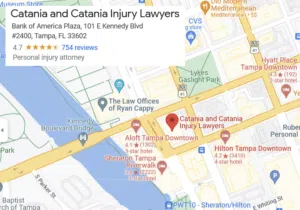
Broken bones are a common injury after an accident. Chances are you may have had a broken bone during your lifetime. Most broken bones heal with medical treatment and a cast. However, some broken bone injuries can be catastrophic and lead to a lifetime of chronic pain.
Here’s what you need to know about broken bones:
Table of Contents
What are Broken Bone Injuries?
At the most basic level, all bone fractures are classified as:
- Open fractures or closed fractures
- Displaced or nondisplaced fractures
Any type of broken bone can have serious long-term consequences. However, some are much more dangerous than others.
Open vs. Closed Fractures
Open fractures are medical emergencies. If your bone has punctured the skin, it’s necessary to seek emergency medical care right away.
In a closed fracture, the skin is not broken. That doesn’t mean the break is any less serious. If you suspect you’ve broken a bone, it’s important to seek medical attention right away. Not only is an experienced doctor’s treatment critical to your recovery, but it can also be important to establish your right to financial compensation.
Displaced vs. Non-Displaced Fractures
When a fracture is displaced, the bone has broken into at least two pieces and moved out of alignment.
In cases involving non-displaced bone fractures, the bone remains in alignment even after it’s broken.
What Are The Different Types of Bone Fractures?
Broken bones are common, but there are a wide variety of fracture pattern types.
Some common types of fractures include:
- Incomplete fractures, or greenstick fractures where the bone is not completely severed
- Transverse fractures, where the break is in a straight line that runs across the bone
- Segmental fractures, where a single bone is broken in more than one place
- Compression fractures, where the bone is crushed
- Oblique, or diagonal, fractures
- Linear fractures, where the break is parallel to the bone lengthwise
- Hairline cracks or stress fractures
- Avulsion fractures, where part of the bone separates from the main bone
- Buckled, or impacted, fractures, where two ends of the bone are driven into each other (common in broken arms, especially in children)
- Spiral fractures, where part of the bone has been twisted at the break site
The type of medical treatment required will depend upon the type of broken bone you’ve suffered. Your recovery time will also depend on the type and severity of the break.
How Common Are Broken Bones?
Most people break a bone at some point in life. In fact, about 6.3 million people break a bone each year in the United States.
Generally, men are much more likely to break a bone than women. However, after age 45, women actually become more likely to suffer a bone fracture.
More than half of all bone fractures involve breaks in the:
- Wrist
- Lower arm
- Hands and fingers
In the lower limbs, nearly ¾ of all fractures occur in the ankles, feet, and toes. Over 300,000 people break a hip in the U.S. each year.
What are the Signs and Symptoms of Broken Bones?
Not all bone fractures are immediately obvious. You should always seek medical care right after an accident, even if you can’t identify any visible injuries.
Some of the signs and symptoms of a broken bone include:
- You hear a popping or snapping sound when the accident happens
- You can see that the limb or joint is visibly out of place, even if the skin isn’t broken
- Swelling, bruising, or bleeding
- Sharp pain
- Inability to move a limb or limited mobility
- You can see the bone piercing the skin
- Your skin is hot to the touch above the injury point
You should also watch for signs like dizziness or fever–they could indicate that you’ve suffered an injury that you can’t see.
What are the Long-Term Consequences of Broken Bones?
With prompt and proper treatment, your broken bone injury could heal completely in time. However, some accident victims suffer serious and ongoing long-term consequences. If your bone was severely broken, you may even require surgery to correct the break.
Some potential long-term consequences of a broken bone injury include:
- Nerve damage, which often happens when bone fragments connect with the nerves
- Infection when the skin is broken or surgery is required
- Joint problems caused by damage to the cartilage
- Anxiety, depression, or PTSD
- Fear of falling
- Loss of strength in the limbs
- Ongoing pain
The physical consequences of a broken bone may only be the tip of the iceberg. Depending upon the victim’s age, broken bones can create problems in even carrying out the activities of daily living far into the future.
What Causes Most Broken Bone Injuries?
The three most common causes of broken bones are trauma, overuse, and osteoporosis.
The following events are frequent causes of broken bone injuries:
- Car accidents
- Slip and fall accidents
- Motorcycle accidents
- Pedestrian accidents
- Bicycle accidents
- Truck accidents
- Sports accidents
- Recreation accidents
- Uber or Lyft accidents
- Boating accidents
- Construction accidents
- Workplace accidents
- Dog bites
- Nursing home abuse and neglect
- Assault and violence
In reality, any type of traumatic accident or incident can cause a bone to break.
What Compensation Can I Recover for Broken Bones?
It can take months to recover from a broken bone. You might require ongoing physical therapy or rehab. You could be out of work for a significant amount of time while you recover or help a family member recover.
That’s why it’s important to recover the full compensation that’s available.
Victims are entitled to compensation for economic damages and non-economic damages in almost all injury cases, including:
- Past and future medical expenses, including ER visits, doctor’s visits, surgeries, etc.
- Lost wages
- Lost future earning capacity
- Rehabilitation
- Pain and suffering
- Emotional distress
- Disfigurement or scarring
- Diminished quality of life
- Loss of consortium
Most broken bone injuries aren’t fatal. However, skull fractures and other complex injuries can be deadly. Florida comparative negligence laws may limit the compensation you can recover if you contributed to your accident.
How Long Do I Have to File a Broken Bones Lawsuit in Florida?
You generally have two years after the date of your injury to file a personal injury lawsuit. This statute of limitations is a strict deadline. Once the four-year anniversary of your accident passes, you’ll no longer have the right to sue for damages under Florida state laws.
Contact a Tampa Personal Injury Lawyer for a Free Consultation
Have you suffered a broken bone in Tampa? You may be eligible to sue for compensation. Our Tampa personal injury attorneys can help you fight to obtain the maximum financial recovery possible.
Catania and Catania Injury Lawyers has over 28 years of experience fighting for injured clients across Tampa. We’ve recovered more than $500 million in compensation to date. Contact our law offices in Tampa, Florida at (813) 222-8656, to schedule a free consultation to learn more.




